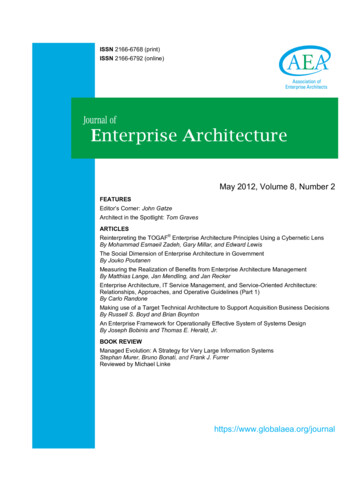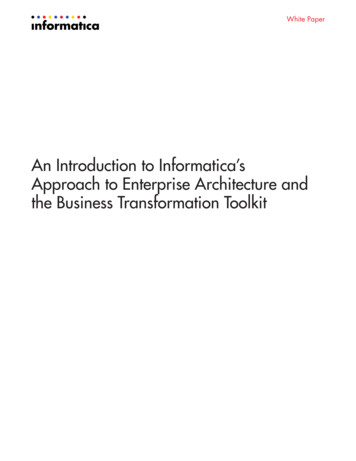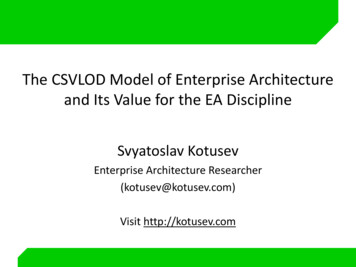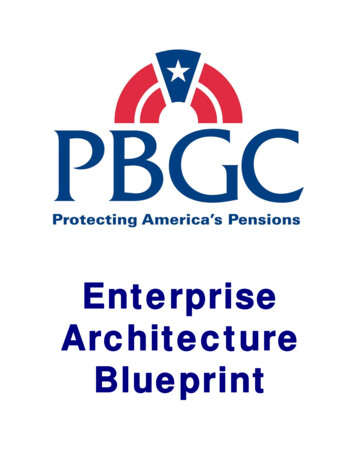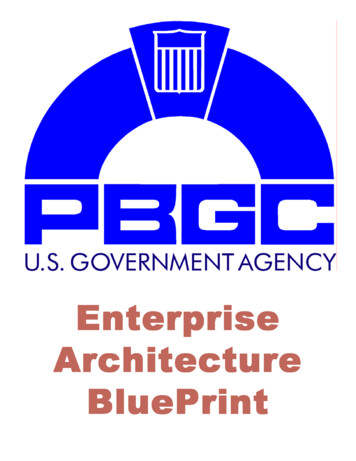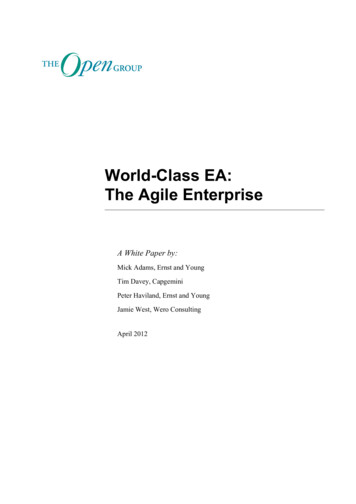
Transcription
ISSN 2166-6768 (print)ISSN 2166-6792 (online)Journal ofEnterprise Architecture2015, Volume 11, Number 1From the Editor: Leonard FehskensChapter Spotlight: AEA Bangalore ChapterSatish K. SreenivasaiahChapter Spotlight: New York Metro ChapterJoe MaisselFour QuestionsJason UppalFour QuestionsDr. Steve Else PhDTalking Shop: A Conversation with Alan HakimiAlan Hakimi, Leonard FehskensShort Subject: How Far up the Tower should Enterprise Architects Climb?Mark PerryEditorial Opinion: Len’s Lens – Introduction to an Editor’s SeriesLeonard FehskensPeer-Reviewed Article: Enterprise Business Motivation Model (EBMM) TRIADS –The Chemistry of Business Architecture AlignmentAtiogbe Didier KoffiPeer-Reviewed Article: Measuring Enterprise Architecture Effectiveness usingKey Performance IndicatorsWendy Arianne Günther and Werner HeijstekBook Review: Ten Books on ArchitectureReviewed by Leonard Fehskens
Journal of Enterprise Architecture President, Association of Enterprise Architects: Allen BrownChief Executive Officer, Association of Enterprise Architects: Steve NunnChief Editor: Leonard Fehskens, Association of Enterprise ArchitectsProduction Editor: Cathy Fox, The Open GroupAssociate EditorsTyson Brooks, PhD, PMPWilliam W. Krauter, PhDCo-Director, Syracuse UniversitySenior Architect, Lockheed Martin CorporationDick BurkHaiping Luo, PhDEnterprise ArchitectInternational Trade Administration, US Dept. of CommerceBrian Cameron, PhDStephen Marley, PhDProfessor & Executive Director, Center for EA, PA State UniversityChief Technologist, Harris CorporationGary DoucetGeorge ParasHuman Resources and Skills Development CanadaManaging Director, EADirectionsRobert Ellinger, PhDPallab Saha, PhDEnterprise ArchitectProfessor of Information Systems, National University of SingaporeSteve Else, PhDP. Kathie SowellEO, EA Principals & Adjunct Professor, University of DenverPresident, Custom Enterprise Solutions, LLC/SowellEACWilliam A. Estrem, PhDEskil SwendePresident, Metaplexity Associates LLCPartner IRM Sweden, President of DAMA ScandinaviaJups Heikkilä, PhDTorben TamboProfessor, University of TurkuAssociate Professor, Aarhus University Institute of Business & TechnologyLeon Kappelman, PhDTim WestbrockCollege of Business, University of North TexasManaging Director, EADirectionsAbout the Journal: The Journal of Enterprise Architecture (JEA) is published by the Association of Enterprise Architects,44 Montgomery Street, Suite 960, San Francisco, CA 94104, Tel: 1 415 374-8280, Fax: 1 415 374-8293,www.globalaea.org. The JEA is a peer-reviewed international publication for the Enterprise Architecture community. Fourissues are published each year. The JEA supports the global practitioner community of interest through the publication ofarticles that promote the profession of Enterprise Architecture, and deals with issues regarding practices and methods,case studies, and standards at the national and international levels. The views expressed in JEA articles are those of therespective authors, and not necessarily those of the publisher, the Chief Editor, the associate editors, or the Associationof Enterprise Architects (AEA).Copyright: 2005-2015 Association of Enterprise Architects. The reproduction, storage, or transmission of JEA articlesor other content is prohibited without prior permission in writing from the JEA Chief Editor, who can be contacted viaemail at l.fehskens@globalaea.org. Trademarks: Association of Enterprise Architects and Journal of Enterprise Architecture are registered trademarks andthe AEA logo is a trademark of the Association of Enterprise Architects.Article Submissions: Authors may submit properly formatted manuscripts to the JEA Chief Editor atjournal.submissions@globalaea.org for publication consideration. Author submission guidelines are available on the AEAwebsite at www.globalaea.org. Copyright of all accepted articles and other published content is transferred by the authorto the JEA upon notification of acceptance by the JEA Chief Editor.Subscription: Available to AEA members. The annual cost of AEA membership is US 75.00. To join, please refer towww.globalaea.org. Online edition: no charge access for AEA members.Back Issues: All back issues of the JEA are available in electronic form, and can be accessed online by AEA members.Libraries can apply for access by contacting the AEA.2 Journal of Enterprise Architecture – 2015 No. 1
ContentsFrom the Editor – About this Issue . 4Chapter Spotlight: AEA Bangalore Chapter . 7Chapter Spotlight: New York Metro Chapter . 9Four Questions: Jason Uppal. 12Four Questions: Steve Else PhD . 13Talking Shop: A Conversation with Alan Hakimi . 15Short Subject: How Far up the Tower should Enterprise Architects Climb? . 21Len’s Lens – Introduction to an Editor’s Series. 23Enterprise Business Motivation Model (EBMM) TRIADS – The Chemistry of Business Architecture Alignment . 28Measuring Enterprise Architecture Effectiveness using Key Performance Indicators . 41Book Review: Ten Books on Architecture . 55 Journal of Enterprise Architecture – 2015 No. 13
From the Editor – About this IssueLeonard FehskensFirst, my sincerest apologies for our having missed a fewissues. But we’re back now, we have taken measures toensure that we will publish regularly, on a quarterlybasis, and we’ve done some things that we believe willsignificantly decrease the time from material submissionto publication.We’re also adding some new kinds of content. We’ll beincluding reports from AEA Chapters, and republishingmaterial from other sources that we think will be of valueto the JEA readership. We’ve resurrected the “Architectin the Spotlight”, but in two different ways that we thinkyou’ll find more interesting. The first is “Four Questions”,where a practicing Enterprise Architect can ask andanswer four questions, related or unrelated, of their ownchoosing. The second is “Talking Shop”, which is anopen-ended conversation between myself and an activemember of the EA community – practitioners,researchers, managers, whatever.As always, I urge you to consider contributing to theJEA. You don’t have to write something to do so – youcan suggest something you’ve seen publishedelsewhere that you think would be of value to the EAcommunity if it were featured in the JEA. If you do wantto write something original, we’re now accepting nonpeer-reviewed short subjects (a few pages) as well asthe traditional peer-reviewed longer articles.We’re especially interested in business and other formsof enterprise-related material, as well as technologicaltopics. Finally, you can always send us your own “FourQuestions”, suggest someone you’d like to have submittheir “Four Questions”, volunteer to “Talk Shop” with me,or suggest someone you’d like me to “Talk Shop” with.This issue opens with reports from the Bangalore andNew York Metro Chapters of the AEA on recent eventsthey held. It continues with two “Four Questions” selfinterviews, and then “Talking Shop” with Alan Hakimi of Microsoft . Then a short subject by Mark Perry on theimportance of the “big picture perspective”. In addition tothe “About this Issue” column and frequent bookreviews, I’ll be contributing a regular series of articles(“Len’s Lens”) about subjects that are “off the beatentrack”, and this issue contains an introduction andoverview of the series. We have two peer-reviewedarticles on subjects of perennial interest to thecommunity, on how to demonstrate that EA actuallydelivers value, and how to connect EA to the business.Finally I review the source of one of the most frequentlycited quotes from the literature of (building) architecture,the “utilitas, firmitas, venustas” of Vitruvius.4 Journal of Enterprise Architecture – 2015 No. 1
Visit the AEA website at www.globalaea.orgCall for PapersThe Journal of Enterprise Architecture is accepting article submissions for its future issues. Research and best practicearticles are sought on Enterprise Architecture-related topics, including: Case Studies, Configuration Management, Culture, Documentation Evaluation, Frameworks, Governance, Implementation, Maintenance Methodologies, Taxonomies, Theory, Training, Tools, Use, ValuePlease send articles to the JEA Chief Editor at journal.submissions@globalaea.org. Author submission guidelines can befound on the AEA website at www.globalaea.org. Journal of Enterprise Architecture – 2015 No. 15
6 Journal of Enterprise Architecture – 2015 No. 1
Chapter SpotlightAEA Bangalore ChapterSatish K. SreenivasaiahKeywordsAEA, Chapter, BangaloreThe idea of pursuing and re-kindling the AEA BangaloreChapter event germinated at The Open Group event inBangalore during the third week of February 2015. Bythe end of two days of insightful sessions on EnterpriseArchitecture (EA), its challenges, and the opportunitiesthat lie ahead for Enterprise Architects in the digitaleconomy, the local architecture community wanted toconnect, share, and collaborate more to keep abreast ofthe latest happenings in the EA space.This thought paved the way for subsequent meetingswith the AEA Bangalore Chapter Lead, Sreekanth Iyerand the core AEA team to discuss the agenda, venue,and relevant logistics for the event. After deliberating onthe plan ahead, the team quickly got into action and,finalized the date of April 9, 2015 for the meet.Topics to be covered and the speakers for the meetwere crowdsourced from the AEA community and finallyzeroed in on the following exciting EA talks. M2M Platform – Architecture & Realization byPrakash Shivappa, Solutions Architect –Happiestminds Web Application Hosting – Cloud Architecture &Realization by Sreekanth Iyer, Executive ITArchitect, IBM Introduction to ArchiMate 2.1 by ParameswaranSeshan, Principal Consultant, CC&C SolutionsIt was decided that the venue would be at the TCS officein the heart of Bangalore. (Thanks to TCS for thevenue.) The event kicked off as planned at 4.00pm withthe enthusiastic crowd eager to share and learn thelatest happenings in the Internet of Things (IoT), its casestudy, cloud architecture realization, and the EAmodeling language.Satish Sreenivasaiah from TCS Product TrustworthyCoE welcomed the AEA members, delivered theopening speech, and invited Mr. Kishore Banavar, TCSHead – Banking Technologies Group, North America todeliver the keynote address.Kishore did touch upon all the key actions that EA as acommunity needs to adopt to be relevant for our Journal of Enterprise Architecture – 2015 No. 1stakeholders – like bridging the gap between businessand technology and owning the digital strategy forenterprises. He emphasized that the future of EA doesnot confine itself to the boundaries of an enterprise butgoes beyond to the industry, and hence EnterpriseArchitects should gear themselves to solve the EAchallenges by sharing and building industry-levelpatterns. He also stressed the need to have prescriptivearchitecture to deliver the new age solutions at the pacethat clients are expecting.In the subsequent sessions, Prakash Shivappa fromHappiestminds presented an IoT case study andexplained the M2M platform architecture adopted, usingsimple analogies. He explained the differences architecture and the IoT architecture implemented. Themultiple layers of the architecture were detailed such asthe device/sensor layer, preparation layer where amessage gets appended with an IP address, theaggregator, big data analytics layer, and finally thesubscriber layer. The growing field of M2Mcommunication and IoT was reinforced in the session.The second session planned was cloud architecturerealization in the context of web application hosting bySreekanth Iyer from IBM. He talked about the CloudStandards Customer Council (CSCC) and containersbased on Docker . It helped the audience tounderstand the concept of leveraging the Dockercapabilities to deploy a container. Being a new area formost of the participants, the session provided insightsinto this upcoming technology space.Lastly, Parameswaran Seshan from CC&C Solutionstalked about the need of Enterprise Architects adoptingthe right modeling language for capturing businessrequirements and depicting it visually addressingmultiple stakeholders’ perspectives. He also talked aboutvarious open source and COTS tools for EA modeling, the differences between UML and ArchiMate, andexplained that “no one tool fits all” and hence adoption ofthe right tools for the right purpose was extremelycritical.7
All the talks were followed by Q&A from enthusiasticparticipants. It was a great two hours spentunderstanding the trends in the EA space andnetworking with like-minded EA professionals. A briefplan was charted for the next AEA meeting in May 2015.REFERENCESCloud Standards Customer Council (CSCC): Web ApplicationHosting Cloud Architecture; refer to: The event ended by the host thanking all participantsand the speakers for delivering top-class presentationsat short notice.ABOUT THE AUTHORSatish K. Sreenivasaiah is a consultant in TataConsultancy Services based in Bangalore. He is part ofthe Product Trustworthy Centre of Excellence that isresponsible for ensuring software security andperformance. He has 16 years of experience in the ITindustry and has held various positions includingSolutions Architect, Lead Architect, Practice Manager,and Relationship Manager across different geographies.He is also an Open Group Master Certified IT Architectand a Certified Ethical Hacker. He has authoredtechnical articles for external and internal publicationsand has been a regular speaker at national andinternational technology forums.8 Journal of Enterprise Architecture – 2015 No. 1
Chapter SpotlightNew York Metro ChapterJoe MaisselKeywordsAEA, Chapter, New York MetroThe New York Metro Chapter of the AEA has over 40members and is growing fast. We’ve held three lively,engaging, and informative meetings. We are currentlyplanning our next meeting and are hoping to hold alarge-scale event in the Fall. Our Chapter is movingforward nicely.But it wasn’t always so.In early 2014 I was changing jobs. I wanted to meetEnterprise Architects in the New York region. I looked fora New York Chapter of the AEA and was surprised tolearn that while both Boston and DC had activechapters, there was nothing in New York. How could thisbe? I contacted the AEA and learned that, sure enough,no one had been able to get a chapter off the ground inNew York.I wondered what it would take to get a chapter startedmyself. Why not take the opportunity if no one else had?It wouldn’t be long before I found out why it was not sosimple in New York.When I called the AEA, it was Birgit Hartje whoanswered the phone and explained the situation in NewYork. She also talked me through what it would take toget a chapter going. I would need to appoint officers: aChair (me), a Vice-Chair, and a Secretary or Treasurer.That much I figured I could do. I called a couple of myformer colleagues from Western Union, Sarose Dassand Jan Stobbe, and they stepped up to the plate.Sarose became Vice-Chair and Jan our Secretary.Birgit recommended that I connect with other AEAChairs that had started their own chapters. She put mein touch with EA luminary Mike Walker. Mike is the Chairof the Texas Chapter and had built it from the ground upto the point where they were holding large events. I hadmet Mike at an Open Group event in 2013. When Ireached him, he generously offered to mentor me onrunning a chapter. He met with me on two differentoccasions and took me through his overall approach,possible pitfalls, and listened patiently as I bouncedideas off him. It was a huge help.But we would, of course, need a place to meet. Journal of Enterprise Architecture – 2015 No. 1Meeting space in Manhattan is hard to come by. OK,that’s not quite true, FREE meeting space in Manhattanis hard to come by (that isn’t in a public park!). It was abit of a catch 22. We were a non-entity with no membersto provide space (I did not have an employer that couldhelp), and without space we could not get established.My former employer, Western Union, does not have astrong office footprint in Manhattan, and so it wasunclear how to proceed. I turned to my co-founders,Sarose and Jan, for suggestions.Sarose was still working for Western Union, spendingmany days in Western Union’s Lower Manhattan office.That particular office did have a very small conferenceroom (max capacity 12), and initially we considered itjust too small for an AEA meeting. But it was all we had.It was now early Fall and we wanted to get something onthe calendar. So Sarose went ahead and reserved thesmall room for Friday, November 14, 2014.At AEA headquarters, Birgit put together a list of all AEAmembers in New York, Connecticut, New Jersey, andPennsylvania. I composed a chapter kick-offannouncement and Birgit sent it out. AEA membershiplists are not freely distributed so Birgit has to be the oneto send out email broadcasts. The email directed anyonewho was interested in the chapter to contact me directly.The response was great. I received over a dozen emailsfrom people expressing interest. I now had a chaptermailing list. I sent out information confirming our meetingtime and location and a proposed agenda. We were onour way! Or so I thought. Just two weeks before themeeting, Sarose called to tell me that Western Union HRwould not approve the use of the conference room forour meeting! What to do? I thought for sure we weresunk.Sharon and IBM to the rescue.I sent out an email to the newly formed chaptermembership apprising them of the situation, asking(pleading/begging) if anyone had access to meetingspace in Manhattan. Right away, Sharon Bowden fromIBM came back with an offer of an IBM conference roomin Lower Manhattan. Suddenly we had new life!9
On the day of our first meeting I was excited but didn’tknow what to expect. I made my way to the IBM officesand up to the meeting room. About a dozen peopleshowed up. Yay! We had a nice mix of EnterpriseArchitects representing a variety of organizations – largetechnology companies, niche EA vendors, independentconsultants like myself, and several others working in EApractices inside Fortune 500 companies or universities.After a round of introductions, handing out copies of theJournal of EA, and explaining how the chapter came tobe, we started to explore what our new chapter shouldfocus on. Someone raised the question: “What is theelevator pitch for the value of Enterprise Architecture?”The conversation took off from there. It seemed that thistopic was on a lot of people’s minds. There was acommon concern that Enterprise Architects don’t haveany easy way to describe the value of what they do totheir peers and to executives. The conversation flowedfreely, around and across the table, debating how best todescribe the value of our profession. After a while werealized that there was a lot more to say about thesubject than we could cover in our first meeting. Wedecided right there that we had the perfect topic for ournext meeting.Now that we had the topic, we needed to come up withan effective format to explore it. Pretty quickly we settledon having chapter members put together shortpresentations on the topic to be given at the nextmeeting. We agreed to issue a “Call for Presentations” amonth or so in advance of the next session.Other ideas for chapter activities were explored includingholding an executive briefing. We would bring together agroup of executives, pitch them on the value of EA, andsolicit their feedback. Another idea was to hold a jointsession with another AEA chapter such as Boston orDC. There were several more, and we decided to remainopen-minded about future possibilities. Our main goalhad been met, namely getting the chapter underway.We also made the decision to keep the officersunchanged, and to not be a dues paying chapter. Wewanted, and still want, to make being a chapter memberas easy as possible. Not having dues also keeps theadministrative overhead to a minimum. We did make arule that you must be an AEA member to attend morethan two meetings.With a core membership established, I hoped it would bemuch easier to find a place to meet. Sure enough bothPaul Brown from TIBCO and Alan Crosswell fromColumbia University offered us meeting space. What arelief! In New York, finding space is the hardest thingand I felt a huge weight lifted off the chapter’s proverbialback.10Our second meeting on February 13, 2015 was held atColumbia. The call for presentations was answered bysix different members, each giving engaging andthought-provoking talks on the value of EA. We openedthe session up to remote users via WebEx (thanks to theAEA for providing a WebEx account!). In fact, four of thesix presentations were given remotely. When they werefinished, a lively discussion ensued. We ran out of timeand a number of us found ourselves hanging outafterwards, continuing the discussion. We kept talking aswe walked down the street, then on to the subway, andall the way until we reached our stops and had to partways.Our third meeting on May 8, 2015 was held at TIBCO.Once again the call for presentations yielded thoughtfulpresentations on the meeting theme “Making EA aReality”. And, as before, the conversations theygenerated spilled out beyond the meeting’s boundaries.We talked in the elevator and out onto the street andthen had to agree that for future meetings we need toschedule an optional lunch for post-meeting discussions!For our next meeting the chapter agreed to formalize itsby-laws, hold officer elections in the Fall (at our one-yearmark), and develop a chapter mission and valuesstatement. We are very excited about the future of theAEA New York Metro Chapter.If you would like to learn more about us, see meetingnotes, and keep up with our activities, please go to ourchapter page on the AEA website.Hope to see you at our next meeting!SUMMARYChapter launch in a box: Confirm there are no other chapters in your area Pull a couple of other architects together to be yourofficers Fill out the form on the AEA website Pick a place and a date Have the AEA send out an email blast to AEAmembers in your region Meet, elect officers, establish by-laws, talk EA, holda big event (if that works!), rinse, repeatABOUT THE AUTHORJoe Maissel is a recognized expert in EnterpriseArchitecture tools, and the current Chair of the New YorkMetro Chapter of the Association of EnterpriseArchitects. With a long career in many facets ofarchitecture, systems engineering, and education, Joe feels at home teaching TOGAF courses and providingtraining on Enterprise Architecture toolsets. Journal of Enterprise Architecture – 2015 No. 1
Joe started his career as an entrepreneur. Hisgroundbreaking website work on soundwire.com wasfeatured in numerous books, magazines, and periodicalsincluding Wired Magazine and The New York Times. Joewas a featured speaker at conferences focused on theInternet and entertainment. He parlayed his passion forthe web into an IT Infrastructure and SystemsArchitecture career, building middleware and unifiedcommunications systems for investment banks such asCredit Suisse and JP Morgan Chase. He was selected tochair the Financial Services Instant MessagingAssociation (FIMA), which he led for three years, andbecame an elected member of the XMPP StandardsFoundation (XSF). Joe was the creator and primaryinstructor for “Web Architecture and Infrastructure” whichwas offered at NYU from 2001 through 2008. The coursebecame required curriculum for students pursuingcertification in web programming. Recently, Joe ledWestern Union’s effort to adopt Enterprise Architecture tools and methodologies. He introduced the use of UMLtools and worked to build a full EA modeling practice based on the TOGAF and ArchiMate industrystandards. Journal of Enterprise Architecture – 2015 No. 111
Four QuestionsA Practicing Architect Asks and Answers Four Questions of Their Own ChoosingJason UppalQuestion 1: You are a Mechanical Engineer and anEconomist by training; how did you end up as a ChiefArchitect, now leading a major transformation program inhealthcare?Engineering education, in my opinion, is one of the besteducation platforms for an architect because it teacheshow to think and how precisely to separate the problemdefinition and solution development phases. Theapplication of this skill in healthcare is like low hangingfruit. There are only a few problems when it comes toimproving the delivery of healthcare, but the solutions wehave are so complex, we spend most of our energy andtime managing inherent complexity in the solutions, cation is key to improving healthcare qualityand cost, but most Healthcare Information Technologysolutions don’t address this simple problem head on.Question 2: From your experience what is the biggestchallenge for EA professionals in the market place andwhat can professional associations like AEA, or consortialike The Open Group and others, do to help?It always comes down to a supply and demand, chickenand egg scenario. We, as an Enterprise Architecture(EA) industry, have not done a very good job at definingexactly what we do and what we as professionals takeresponsibility and accountability for. If architectureprofessionals want to be taken seriously in the enterprisethey have to put a stake in the ground. Just likeIndustrial Engineers were the right-hand person of aPlant Manager, EA professionals need to be the righthand person of the CIO and every other line of businessexecutive, and then we have to take responsibility for theperformance of enterprise capabilities just like theindustrial engineer. When we have demand then we canstart to create supply. There are lot of people inorganizations who are ready to fill this role.what obstacles do we as an industry need to overcometo help them position these services. The 13-month longjourney to share our proposed model with broad EApractitioners revealed remarkable insight. We will besharing our findings at The Open Group event inBaltimore in July 2015. Looking at all the data wecollected, one insight we gleaned is that the market isready and we just need to step up to the plate.So far we have gained good insight into the state of EAprofessionals in enterprises. The next step is to engagemore EA professionals to finalize the EA servicesdelivery model with complete guides and examples andhand this material to an organization like the AEA or TheOpen Group to further develop, manage, and distribute.The challenge will be and often is to communicatebroadly and make it self-sustaining.Question 4: What advice can you give to an aspiringengineer, manager, system developer, or a futureEnterprise Architect?I am not big on advice, as I feel what I know is notenough. But Chris Hadfield, a Canadian astronaut oncestsaid: you need three things to succeed in life – 1ndbecome very good at what you do, 2 become arddecision-maker, and 3 take care of your health. I canadd that aspiring EA professionals should build goodrelationships with their stakeholders, take responsibilityfor results, and solve the real problem.ABOUT THE ARCHITECTJason Uppal is a P.Eng, Open CA Level 3 Certified ChiefArchitect. Currently Jason is working on two projects –architect, build, and distribute enterprise capabilities tomake Zero Patient Harm a reality, and bring EnterpriseArchitecture education to Indian higher educationinstitutions.Jason can be reached at Jason.uppal@icarequality.org.Question 3: Your recent research project – Moving EAbeyond Modeling and Advisory – what were you hoping toaccomplish with this and where do you expect to take it?I started this project with two research questions – first,what services should an EA professional provide in orderto be considered a direct value generator, and second,12 Journal of Enterprise Architecture – 2015 No. 1
Four QuestionsA Practicing Architect Asks and Answers Four Questions of Their Own ChoosingDr. Steve Else PhDQuestion 1: What are your overall impressions about thepractice of EA in 2015?The people interested in Enterprise Architecture (EA) areoften IT people, very talented ones, but not necessarilythe best ones to explain what it is and why it matters.Whereas many IT pro
Peer-Reviewed Article: Enterprise Business Motivation Model (EBMM) TRIADS - The Chemistry of Business Architecture Alignment Atiogbe Didier Koffi Peer-Reviewed Article: Measuring Enterprise Architecture Effectiveness using Key Performance Indicators Wendy Arianne Günther and Werner Heijstek Book Review: Ten Books on Architecture




